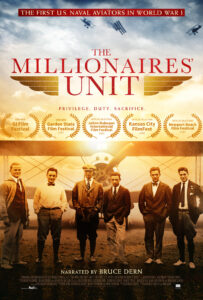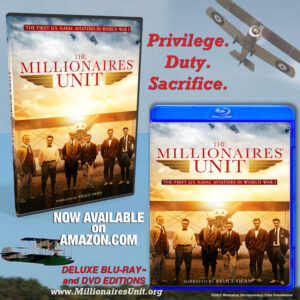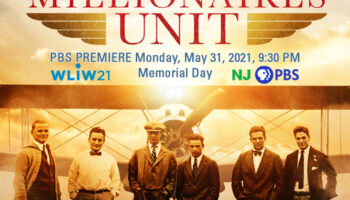On Memorial Day – Monday, May 31, 2021, The Millionaires’ Unit (one-hour version)…
News

Welcome to the web site dedicated to the First Yale Unit and the documentary film, The Millionaires’ Unit – The First U.S. Naval Aviators in World War I. The Millionaires’ Unit is the story of a privileged group of college students from Yale who formed a private air militia in preparation for America’s entry into World War One. Known as the First Yale Unit, and dubbed ‘the millionaires’ unit’ by the New York press, they became the founding squadron of the U.S. Naval Air Reserve and were the first to fly for the United States in the Great War.
Using the words of these pioneer aviators from their letters and diaries, the documentary tells the story of young men coming of age as America was coming of age as a world power. Their service and sacrifice is the great untold story of American aviation in World War One.

This deluxe edition, 2 DVD set or Blu-ray™ (requires Blu-ray™ player) contains the original 2-hour feature and an additional disc containing an hour of bonus material including four supplementary featurettes: From Sea Legs to Navy Wings —The Birth of U.S. Naval Aviation Killingholme: Hunting the German U-boat, Flying the Sopwith Camel and The Making of The Millionaires’ Unit. Plus, the original trailer and an eight-page booklet containing an appreciation by Marc Wortman, author of the book that inspired the film, The Millionaires’ Unit (ISBN 1586484443)
Narrated by Oscar®-nominated actor Bruce Dern, grand-nephew of one of the pilots, this documentary epic was filmed in England, France and Belgium and along the Eastern Seaboard
Winner of multiple Best Documentary Feature film festival awards, The Millionaires’ Unit features stunning re-enactments and dogfights filmed air-to-air with period aircraft.
An intimate, character-driven story set in the historical context of …the birth of naval aviation, and the drama and tragedy of the First World War — G.I. Film Festival
TMU Donors
A very special thank you to all of the contributors who made The Millionaires’ Unit documentary possible.
Federal Express – Corporate Sponsor
Bank of America
David Anderson
John Anderson
John Artz
Andy Bacas
Susan Baker
David Ball
Johnathan Bergner
Sarah Bertasi
Jamie Nicholls and Fran Biondi Charitable Trust
Taylor Bodman
Patrick Boyle
Adele Brown
Christopher Brown
G & I Butler Family Foundation – Ildiko Butler
Kyra Cheremeteff
Greater Cincinnati Foundation
JP Morgan Chase & Co.
Richard R. Davis
Steve Davis
Alexander “Max” Davison
Catherine C. Davison
Danny Davison
James S. Davison
Jane Ingalls Davison
Malcom P. Davison
Mrs. Daniel P. Davison
Daniel Davison III
Daniel P. Davison Jr.
Warren Dean
Dewey Deeton
Laura F. Dunn
Sarah Frost Eames
Carmel Ann Ferrara
Helen Fitz
Betty Lou Frost
Lawrence W. Frost
The Perkin Fund
Louis S. Gimbell III
Robert S. Gordon
Florence Gould Foundation
David B.L. Gould
George M.L. Gould
John D.B. Gould
Hayden Technologies
Thomas Heath
David Herskovits
James Higgins
League of World War I Aviation Historians
Joe Holland
Paula Hornbostel
Margo House
Louise H. and David S. Ingalls Foundation
Teenie St. John-Brainerd
Joanne E. Johnson
Anne Karalekas
Ellen Kazimer
Christopher Kelly Family Foundation
Michael Kempner
Matthew Kenaston
Holly King
Kendall C. King & Mary Vorys King
Jill Kingsley
Ottavio Serena Di Lapigio
Richard Lawrence Jr.
David Lawrence
Richard H. Lawrence
Ambassador Howard and Gretchen Leach
Howard & Gretchen Leach
Dorothy Deh Lovett
Alex P. Lynch
Alexander and Sally Lynch
Podie Lynch
Rosann MacGregor
Marjorie A. Matheson
Allison Abbott & Matthew
Elizabeth G. Miller
Glenn Morrisey
Wilson and Eliot Nolen
Patrick O’Connell
George L. Ohrstrom Jr. Foundation
Thomas Opladen
Barry Osborn
Overlook International Foundation
Stephen Plumlee
Puck Purnell
Darley Randall
Peter J. Regina
George P. Davison Judith F. Rivkin
Donald M. Roberts
Fred Roos
Roger H. Samet
Elliot Scott
Lawrence D Sheely
Arlene Solomon
Eliot Spitzer
Katharine Streitwieser
Carol Lee Sutherland
Mr. Andrew and Mrs. Barbara B. Taylor
Peter Toulmin
Sunny Toulmin
Stanley Trotman, Jr. Trust
Dolly Truxel
- Duke Vincent
Art & Ann Vorys
Martin Vorys
Beverly Walker
Philip Walker
Kay F. Wilder Trust
Mark Wilson


